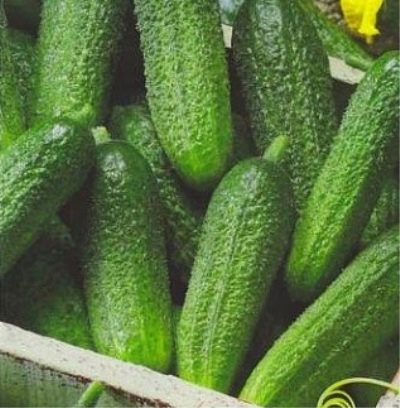
- Authors: Nastenko N.V., Kachainik V.G., Gulkin M.N.
- Year of approval: 2013
- Growth type: indeterminate
- Branching: weak
- Fruit weight, g: 85-95
- Fruit length, cm: 7-11
- Fruit color: green with medium stripes and medium mottling
- Cucumber Mosaic Virus Resistance: medium resistant
- Ripening terms: early
- Fruit shape: cylindrical
The cucumber variety with the funny name Espagnolette is a thermophilic and unpretentious hybrid. It grows well in many regions of Russia.
Breeding history
The emergence of the variety in 2012, we owe to domestic breeders: N.V. Nastenko, V.G. Kachainik, M.N. ...
Description of the variety
The plant is indeterminate, slightly branched, female flowering type. With proper care, the Espagnolette reaches medium height.
Characteristics of the appearance of plants and zelents
The bush, the main branch of which reaches an average of 50-60 cm, has medium-sized leaves of dark green color. The number of female flowers in one node reaches two or three.
The fruits of the Espagnolette are short, 7-11 cm. The average weight of one is 85-95 g. Cucumbers have a small tuberous surface with mottling over the entire surface.
Purpose and taste of fruits
The hybrid has a universal purpose. The taste prescribed by the tasters is excellent and without bitterness.
Maturation
In terms of ripening, Espagnolette is a mid-early variety. The period from the first shoots to fruiting takes 53-55 days.
Yield
Espagnolette is considered a medium-yielding variety. An average of 13.3-14 kg is collected from one square meter.
Growing regions
The variety is found in almost all regions of our country. It is grown in:
north;
Northwest;
Central;
Volgo-Vyatsky;
North Caucasian;
Middle Volga;
Nizhnevolzhsky;
Uralsk;
West Siberian;
East Siberian;
Far Eastern regions;
CChO.
Landing scheme
The plant is planted according to the scheme 50 x 40 cm, where the first value is the distance between the bushes, the second is the distance between the beds. Thus, you will plant no more than 4-5 plants per 1 m2 for open-ground cultivation or 2-3 per 1 m2 for cultivation under film.
Growing and care
Seeds are planted only in the third decade of May - early June. The transfer of seedlings is carried out no earlier than June.
In the fall, the site (which is always in the sun) is dug up. For the winter, peat and humus are introduced, with the onset of frost - top dressing from compost. The site is re-loosened in the spring, sawdust is introduced into it. An important condition is a suitable soil temperature. It must be at least 15 degrees Celsius.
Before planting, the seed is disinfected, leaving it to soak in a 1% manganese solution for half an hour.
The sufficient depth of the hole for the Espagnolette is 3 cm. The sown seeds are well watered with warm, settled water and covered with a thick film.
Espagnolette seedlings can be planted in peat pots and other containers like plastic cups. They are left in a dark, dry and warm place with a temperature of 25-27 degrees. After the first shoots, it drops to +18, the seedlings are transferred to a lighted place. The appearance of the second leaf is a signal that the first feeding with a solution of nitroammophoska and warm water can be carried out.
The seedlings are transferred into holes 5-7 cm deep, when the fifth or sixth leaves appear on the plants. When grown vertically, the bushes are blinded to the fourth leaf. Sprinkle the seedlings with earth in the root area, watered abundantly and cover with foil or agrofibre.
The espagnolette needs periodic watering at the root. It is recommended to do them either in the morning or in the evening. The normal schedule is every three days.
The bushes of this hybrid are tied up and formed into one main stem. Plants are tied up vertically, on trellises or twine. The lower and weak shoots are cut off, and the top is pinched.
It is enough to feed the espagnolette three times per season, observing a frequency of 2 weeks between approaches. Gardeners advocating top dressing advise using nitrogen-containing fertilizers (manure, urea), mineral fertilizers (phosphorus, superphosphate, nitrophoska), as well as top dressing containing potassium.
Hilling of cucumbers occurs only after watering. It is enough to loosen the area and add 10-20 cm to the ground level in the root area, tamp it slightly. Number of approaches: once every 10-14 days.

In order to collect strong, tasty and beautiful cucumbers on your site, you need to make top dressing. Lack of nutrients can negatively affect the appearance of the plant and significantly reduce the yield. Fertilize cucumbers with organic fertilizers in combination with mineral fertilizers. With the right balance of these components and adherence to the fertilizing schedule, the cucumber yield will be maximum.
Disease and pest resistance
Espagnolette has good immunity. It has medium resistance to:
cucumber mosaic virus,
cladosporiosis (brown olive spot),
powdery mildew,
downy mildew.
Let's consider what to do in other cases.
Alternaria The disease is characterized by the formation of dry spots on the lower part of the leaves, as well as their twisting and death of fruits. It is treated: with preparations "Poliram", "Bravo" or "Quadris", as well as solutions of copper oxychloride or Bordeaux mixture.
White rot. You can recognize it by wet and slimy spots on the leaves. It is necessary to stop watering, the bushes are treated with the preparations "Hom", "Rovral" or "Bayleton".
Ascochitis. An infection with similar symptoms. Leaves and fruits begin to dry and fall off. It is treated: solutions of vitriol, urea, or Bordeaux mixture.

Despite their popularity, cucumbers are often attacked by diseases and pests. From them, cucumber plantings often die before the start of fruiting. In order to prevent this from happening, it is necessary to try to prevent ailments or get rid of them at the very beginning, having studied in detail their causes of occurrence, signs and methods of treatment.





























































































